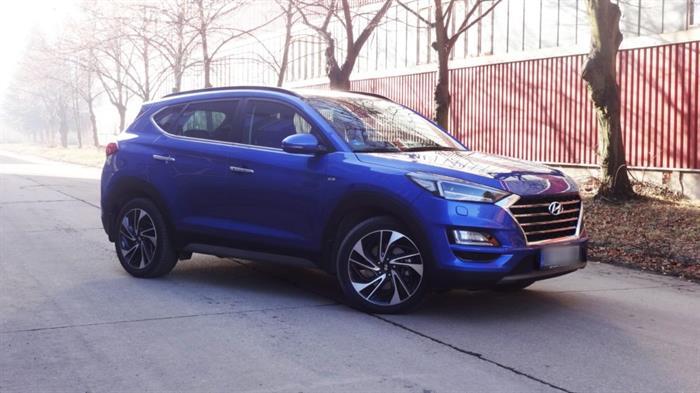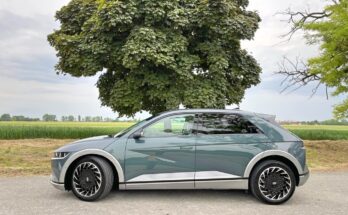Hyundai Tucson, known to the editors as the representative of this Korean brand, underwent a classic facelift in the middle of last year. In addition, a mild hybrid version was added to the facelift quite recently. The facelifted Tucson, with a mild hybrid powertrain, two-liter diesel engine, automatic transmission, all-wheel drive and top-of-the-line STYLE equipment, became our editor's car of the week last week.

Rejuvenating peel
The current Tucson facelift belongs to the category of rather decent and quite successful. Even before the facelift, I liked the Tucson for its dynamic design and for a certain robustness, mainly in the rear part. Both the front and rear of the car received corrections. The radiator grille received a more pronounced side edging, the bumper slightly changed its structure, as well as the front lamps. The rear part has newly shaped lamps and the fifth door has also seen a slight change. So the automaker succeeded in modernizing the Tucson, the tested specimen also had the appropriate blue additional color "Champion Blue" or 18-inch light alloy wheels.

Still spacious interior
Rejuvenation, of course, had no negative effect on the roominess of the interior, which the car already had before. However, the dashboard received light retouches. The new eight-inch infotainment touchscreen "sticks out" (eight-inch only with STYLE equipment). The technology here has advanced and the new display has slightly better graphics and a faster response to your commands. It can also be controlled from the multifunction steering wheel, the controls of which are traditionally associated with a pleasant ride at Hyundai. For me, the weaker side of the steering wheel is its appearance, it has a fairly flat center, which, compared to, for example, the Santa Fe model, gives a slightly cheaper impression. The appearance of the dashboard is quite neutral, but its workmanship is of high quality. The center panel is equipped with an automatic transmission selector, to which the controls for selecting the driving mode, deactivating the start x stop system, activating the hill-start assistant or the camera display control are assigned in the same frame, a nice and compact detail.
The front seats are generously sized, heated and ventilated. The rear positions do not offer a sliding bench, but allow the backrest to be folded down more into the luggage compartment. Thanks to the presence of the battery of the mild-hybrid system, it is reduced by approx. 54l to 459l.
The interior of the Hyundai Tucson, even after modernization, has not lost any of its original qualities. So it is still functional, spacious and well-made.

Tucson also changed power units as part of the modernization. The pinnacle of diesel engines is the two-liter CRDi with an output of 136 kW. This motorization is now also offered in a mild hybrid version, which was available in our tested car. The mild hybrid with this motorization is further connected to either a six-speed manual or an eight-speed automatic.
So what is it really about? Compared to the classic two-liter diesel, the vehicle is additionally equipped with a battery with a capacity of 0.44 kWh, which stores electrical energy generated by the recovery of kinetic energy. The vehicle is also equipped with a starter-generator that can reuse this electrical energy. As for the driving expression, the mild hybrid does not manifest itself significantly. The car simply behaves like a classic diesel with automatic transmission. However, the change occurs in the very behavior of the start x stop system. Thanks to the accumulated electrical energy, the car can switch off the engine much earlier, specifically when the brake is slightly activated and when the speed drops below 30 km/h. Restarting the engine becomes significantly faster. This is where the first "advantage" of the mild hybrid design comes in, and it should be a certain fuel saving (by about 7%), then a reduction in CO2 emissions. I, however, consumed around 7.7 liters with the car during the weekly test. Another advantage is the slight power assistance of the diesel engine with electric energy. This happens during acceleration, with a power of up to 12 kW.
Mild hybrid is therefore, as the name itself suggests, a kind of step before the classic hybrid. However, a mild hybrid is not capable of purely electric driving, for example, but it can recover energy and convert it into electrical energy for further use.

Overall rating
Personally, I find it quite difficult to decide on the verdict, reusing otherwise lost energy is certainly a good way, but the question is how this technology is offered to you.
One of the things I appreciate about the Tucson is its interesting purchase price, the car is currently offered in the basic version from CZK 549,990 including VAT.
However, the mild hybrid version is only available with a two-liter diesel engine, which you will only get with the STYLE equipment. For this you will pay an additional 110,000 CZK including VAT. However, you also have to pay extra for the diesel engine itself, a whopping 205,000 CZK including VAT, in the case of the tested automatic transmission. And another 30,000 CZK will cost you a mild hybrid system.
Thus, the purchase price of the tested car with the additional premium package and additional color was CZK 982,890 including VAT.
As such, the Hyundai Tucson has not lost any of its positive features as part of the modernization, it still has a spacious and well-crafted interior, a robust and dynamic exterior and potent driving characteristics.
As far as the mild hybrid system is concerned, unfortunately, the price policy of the car company bothers me, when the motorization that cooperates with this technology is tied to the level of equipment, which makes the purchase price quite expensive.
So the Tucson is certainly a good choice, but I would strongly consider a mild hybrid drive system.

























